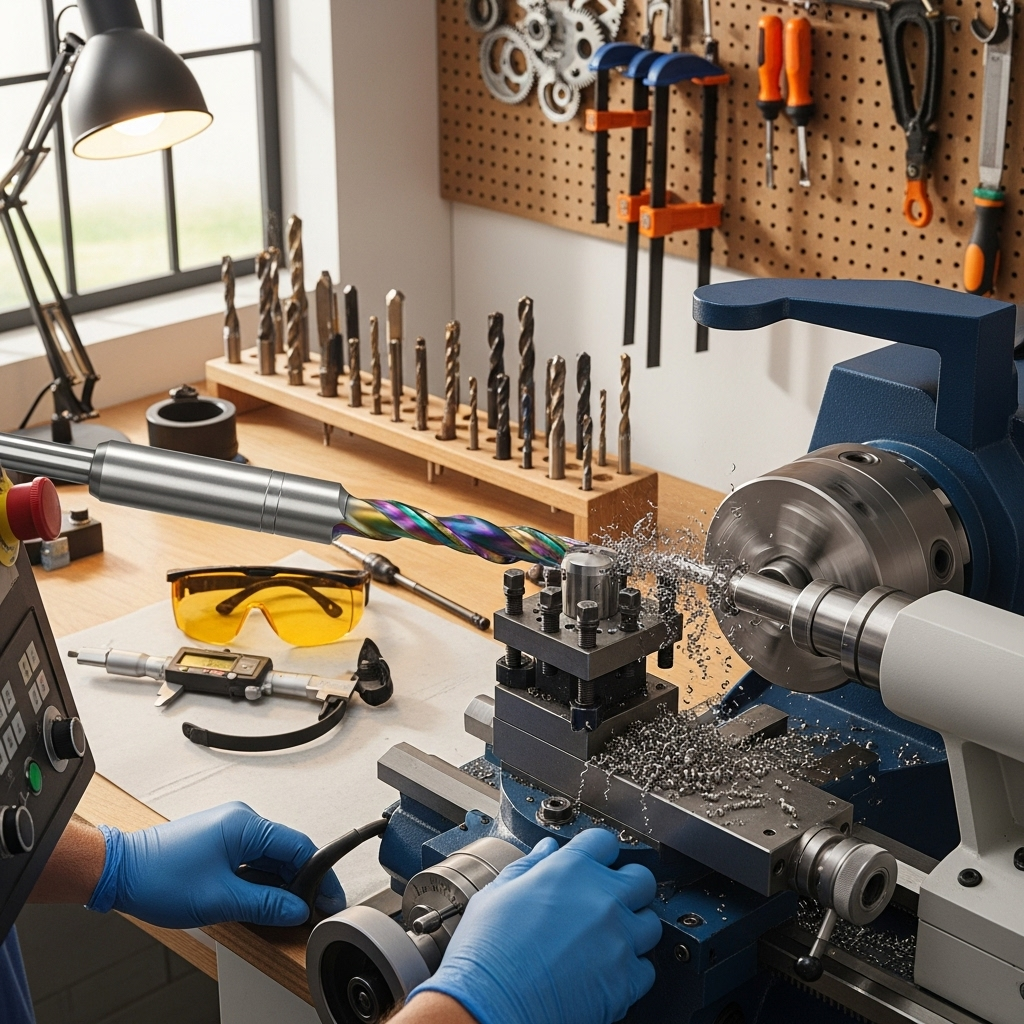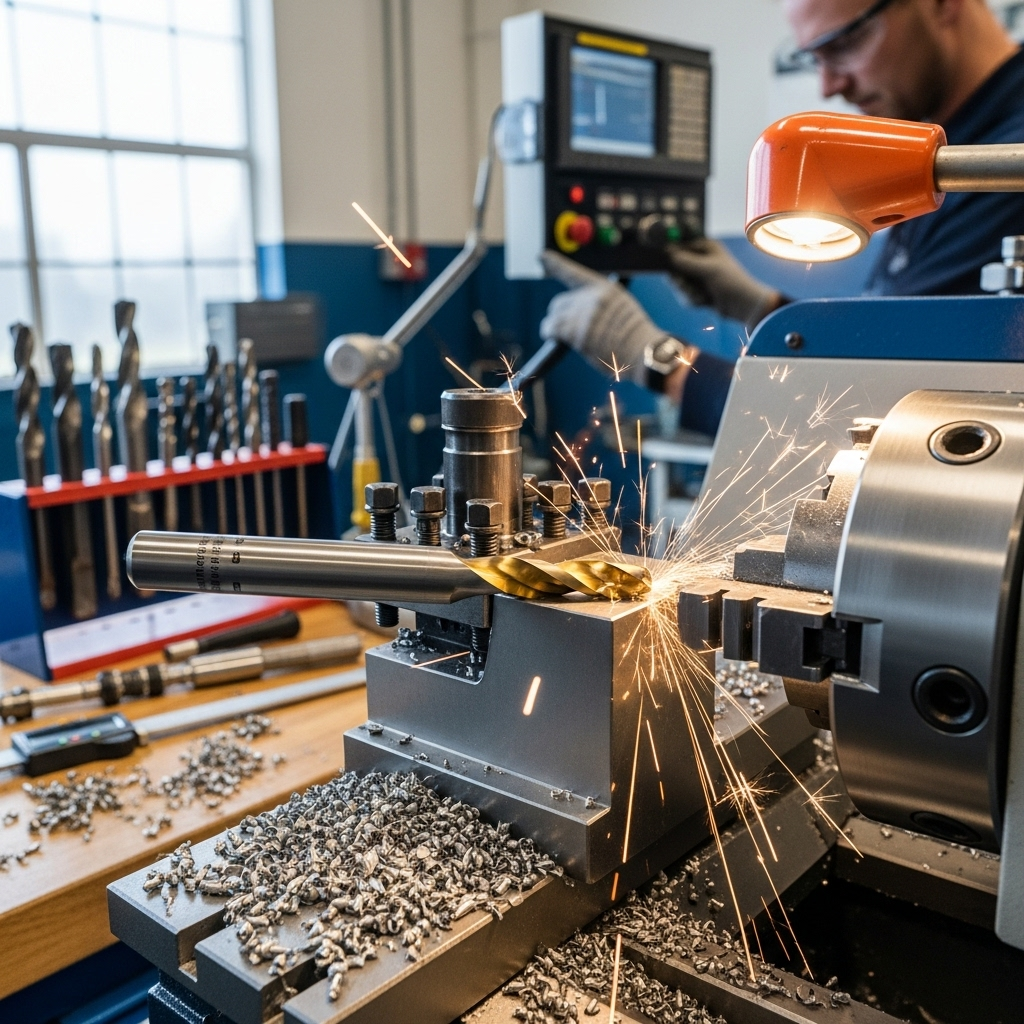Carbide end mills are indeed a proven and often preferred choice for machining hard materials like titanium alloys, offering superior hardness, heat resistance, and edge retention compared to traditional high-speed steel (HSS) tools. For titanium grades, especially the common Grade 5 (Ti-6Al-4V), selecting the right carbide end mill with appropriate geometry, coatings, and machining parameters is key to achieving efficient cutting, good surface finish, and tool longevity.
Machining titanium can feel like wrestling with a stubborn beast. It’s tough, it can get hot really fast, and it doesn’t always play nice with standard cutting tools. For beginners, this can be a source of frustration and, honestly, a bit intimidating. You want to get that perfect cut on your project, but you’re worried about breaking the tool, overheating the workpiece, or just getting a messy result. The good news is, with the right knowledge and the right tools, machining titanium becomes much more manageable. Today, we’re going to focus on a champion in the fight against tough metals: the carbide end mill. We’ll explore why it’s so good for titanium and how to pick the right one for your milling projects.
Why Carbide is King for Titanium
When you’re dealing with a material as strong and heat-resistant as titanium, standard tools often struggle. They can dull quickly, generate excessive heat, and lead to inefficient machining. This is where carbide end mills shine. Let’s break down why they’re so effective:
- Hardness: Carbide is significantly harder than High-Speed Steel (HSS). This means it can cut through tough materials like titanium without easily deforming or losing its sharp edge. Think of it like using a diamond-tipped saw versus a regular saw blade for cutting the hardest wood; the diamond edge will cut cleaner and longer.
- Heat Resistance: Machining metals creates friction and, therefore, heat. Titanium is particularly prone to transferring heat into the cutting tool, which can lead to tool failure. Carbide can withstand much higher temperatures than HSS, allowing for faster cutting speeds without the tool softening or degrading.
- Edge Retention: Because of its hardness and heat resistance, a carbide end mill can maintain its sharp cutting edge for much longer. This means fewer tool changes, more consistent cutting performance, and a better quality finish on your titanium parts.
- Rigidity: Carbide is a denser, stiffer material than HSS. This rigidity helps to minimize tool deflection, which is crucial when precise dimensions are needed. For titanium, where tool chatter can be a problem, a rigid carbide end mill helps maintain a stable cut.
Understanding Titanium: The Challenge

Before we dive into carbide specifics, it’s helpful to understand why titanium is so challenging to machine. It’s not just brute force; it’s a combination of properties:
- Low Thermal Conductivity: Titanium doesn’t dissipate heat well. Most of the heat generated during cutting gets trapped in the chip and the cutting edge. This localized heat can quickly lead to tool wear and thermal damage if not managed properly.
- High Strength and Toughness: Titanium alloys have a very high strength-to-weight ratio. This means they are strong and resilient, requiring significant cutting forces to displace the material. They can also work-harden significantly, meaning the surface of the material can become even harder as you cut it.
- Gummy and Sticky Nature: Titanium tends to “gum up” on the cutting edge. This can lead to poor chip formation, rapid tool wear, and a less-than-ideal surface finish.
These characteristics mean that you can’t just grab any old end mill and expect great results when working with titanium. You need a tool specifically designed to tackle these unique challenges.
Choosing the Right Carbide End Mill for Titanium
So, we know carbide is the way to go. But not all carbide end mills are created equal, especially when it comes to titanium. Here’s what to look for:
Material Grade and Geometry
The specific grade of carbide and the end mill’s geometry are critical. For demanding applications like machining titanium, you’ll want:
- Sub-micron or Micro-grain Carbide: This refers to the size of the tungsten carbide particles. A finer grain structure (sub-micron or micro-grain) results in a harder, tougher, and more wear-resistant tool.
- Specific Geometries:
- High Helix Angle: Look for end mills with a high helix angle (often 30-45 degrees or more). This provides a shearing action that helps lift chips away from the cutting edge and reduces the forces on the tool. It also helps to reduce the tendency of titanium to “gum up.”
- Variable Pitch (or Unequal Spacing): Some end mills have teeth that are not equally spaced around the circumference. This can help break up the harmonic vibrations that can occur during cutting, reducing chatter and improving surface finish.
- Right-Hand Cut, Right-Hand Spiral: This is the standard configuration for most milling. It means the tool rotates clockwise to cut, and the flutes spiral upwards to help evacuate chips.
- Corner Radii or Chamfers: A small radius or chamfer on the cutting corners can add strength to the edge, reducing the risk of chipping, especially when taking heavier cuts.
Coatings: The Protective Shield
Coatings are thin layers of extremely hard material applied to the surface of the end mill. They significantly improve performance, especially on difficult-to-machine materials like titanium.
- AlTiN (Aluminum Titanium Nitride) / TiAlN (Titanium Aluminum Nitride): This is a very popular and effective coating for machining stainless steels and titanium alloys. It forms a protective aluminum oxide layer at high temperatures, allowing the tool to run hotter without degrading. It’s excellent for dry machining or with minimal coolant.
- TiCN (Titanium Carbonitride): Offers good wear resistance and lubricity, often used in general machining. While good, AlTiN is generally preferred for titanium.
- CrN (Chromium Nitride): Another option that provides good lubricity and resistance to diffusion wear, which is helpful for sticky materials.
For titanium, AlTiN or TiAlN coatings are usually the top choice due to their ability to handle the high temperatures involved.
Number of Flutes
The number of cutting edges (flutes) on an end mill affects its performance:
- 2 Flutes: These offer more chip clearance. This is often beneficial for deep slots and pockets, and materials that produce long, stringy chips like titanium. The reduced number of cutting edges also means less cutting pressure per flute.
- 3 Flutes: A good balance between chip clearance and stability. They can be used for general-purpose milling, but might struggle with very deep cuts in gummy materials compared to a 2-flute.
- 4+ Flutes: While offering more rigidity and a smoother finish in softer materials, they can lead to poor chip evacuation and increased risk of chip recutting in titanium. They are generally not recommended unless you are doing very shallow finishing passes or peripheral milling where chip packing isn’t an issue.
For titanium, especially Grade 5, end mills with 2 or 3 flutes are typically recommended. A 2-flute end mill is often favored for its superior chip evacuation capabilities, which is crucial for preventing built-up edge and overheating.
Tool Size and Length
When looking for a specific tool, you might encounter terms like “carbide end mill 3/16 inch 10mm shank extra long for titanium grade 5 high mrr.” Let’s break that down:
- Diameter: “3/16 inch” refers to the diameter of the cutting end. The diameter will dictate the maximum width of the slot you can cut and influence the cutting forces.
- Shank Diameter: “10mm shank” means the part of the tool that goes into your collet or holder is 10 millimeters in diameter. This is important for ensuring compatibility with your machine’s tooling system. Most common shank sizes are 1/4″, 1/2″, 6mm, 8mm, 10mm, 12mm, etc.
- “Extra Long”: This indicates the overall length of the tool. An extra-long end mill provides a greater reach, allowing you to machine deeper features or access parts of a workpiece that are further away from the spindle. However, longer tools are less rigid and more prone to vibration, so they require slower cutting speeds and feed rates.
- “For Titanium Grade 5”: This is a clear indication from the manufacturer that the tool has been designed with the properties of Grade 5 titanium (Ti-6Al-4V) in mind, likely incorporating the geometry and coatings discussed earlier.
- “High MRR”: MRR stands for Material Removal Rate. A tool marketed as “high MRR” is designed to cut material quickly and efficiently, meaning it can handle higher feed rates and/or axial depths of cut.
Selecting an appropriately sized and suited end mill (diameter, shank, and length) for your specific operation is as important as the material properties of the tool itself.
Key Machining Parameters for Titanium with Carbide End Mills

Having the right tool is only half the battle. How you use it is equally important. Machining titanium requires careful attention to speed, feed, and coolant.
Cutting Speeds (Spindle Speed)
The rotational speed of your spindle (measured in RPM) needs to be set correctly. Titanium is generally machined at lower surface speeds (SFM or m/min) compared to aluminum or mild steel. For carbide end mills, typical starting points for titanium might be:
- Surface Speed: 150 – 400 SFM (Surface Feet per Minute) or 45 – 120 m/min. This is a starting point. Factors like the specific alloy, machine rigidity, coolant, and cutter coating can push these numbers up or down.
- Calculation Example: If you have a 1/2″ diameter end mill and want to run at 250 SFM, your spindle speed (RPM) would be calculated as: RPM = (SFM 3.82) / Diameter. So, (250 3.82) / 0.5 = 1910 RPM.
Always consult the tool manufacturer’s recommendations for their specific end mills and coatings.
Feed Rates
The rate at which the cutting tool moves through the material is critical for chip formation and heat management. For titanium, you need enough feed to ensure a proper chip forms and to prevent rubbing, but not so much that you overload the tool or machine.
- Chip Load: This is the thickness of the material removed by each tooth of the end mill. For titanium, a chip load of 0.001″ – 0.003″ per tooth is a common starting point for smaller diameter end mills. Larger diameters can handle slightly more.
- Calculation Example: If you have a 3-flute end mill and want a chip load of 0.002″ per tooth, and your spindle speed is 1910 RPM (from above), your feed rate (IPM – Inches Per Minute) would be: IPM = RPM Number of Flutes Chip Load. So, 1910 3 0.002″ = 11.46 IPM.
It’s often better to start conservatively and increase the feed rate if the cut is smooth and the chips look good. You’re looking for a healthy, well-formed chip that breaks into manageable pieces without excessive heat.
Coolant and Lubrication
Effective cooling and lubrication are essential when machining titanium. Without it, heat buildup will rapidly destroy your carbide end mill and ruin your workpiece.
- Flood Coolant: A copious amount of coolant delivered directly to the cutting zone. This is ideal for flushing chips, cooling the tool and workpiece, and lubricating the cut.
- Through-Spindle Coolant (TSC): If your machine has TSC, this is highly effective as it delivers coolant directly through the flutes of the end mill, right to the cutting edge.
- MQL (Minimum Quantity Lubrication): A fine mist of lubricant and air. This can be effective for titanium, saving on coolant costs and mess, but requires proper setup to ensure adequate lubrication and chip evacuation.
- Cutting Fluid/Oil: For manual machines or simpler setups, a good quality synthetic cutting fluid or a specialized titanium milling oil applied externally can help.
The goal is to keep the tool and workpiece as cool as possible and to lubricate the cutting action. Never machine titanium dry with standard carbide end mills if you can avoid it.
Depth of Cut and Stepover
These parameters dictate how much material you remove with each pass.
- Axial Depth of Cut (DOC): How deep the end mill cuts into the material along the spindle axis. For true slotting (cutting a full-width slot), the DOC should ideally be less than the diameter of the end mill. For pocketing or profiling, you’ll take multiple shallower passes. Start with a conservative DOC (e.g., 0.5x diameter) and adjust upwards if machining conditions allow.
- Radial Depth of Cut (Stepover): The amount of overlap between successive passes of the end mill when milling a larger area or profiling. For titanium, a smaller stepover (e.g., 20-40% of the end mill diameter) can help maintain consistent cutting forces and improve surface finish. As you get closer to finishing operations, you might reduce the stepover further.
Practical Tips and Techniques
Here are some additional tips to help you succeed:
- Rigidity is Key: Ensure your workpiece is securely clamped. Use short, rigid tooling whenever possible. Avoid long, thin end mills if a shorter one will do.
- Chip Evacuation: Always try to orient your machining strategy so chips are cleared away from the cutting zone. Air blast can help if coolant is not ideal for a specific pass.
- Listen to Your Machine: Pay attention to cutting sounds. A smooth, consistent hum is good. A chirping, chattering, or grinding sound indicates a problem – usually too high a feed, speed, or an inadequate cut.
- Break-in Passes: For new carbide end mills, especially on tough materials, a “break-in” pass at slightly reduced speeds and feeds can help seat the tool and prevent sudden chipping.
- Inspect Your Tool: Regularly check your end mill for wear, chipping, or signs of heat discoloration. Dull tools are dangerous and inefficient.
- Use a Tool Holder with Good Runout: A high-quality collet or tool holder that ensures the end mill runs true (minimal runout) is vital for predictable performance and good surface finish.
When is an “Extra Long” Carbide End Mill Worth It?

While we’ve emphasized rigidity, there are times when an “extra long” carbide end mill is necessary. These typically feature:
- Longer reach for deep pockets
- Access to intricate internal features
- Machining taller workpieces without repositioning
The trade-off for this reach is reduced rigidity. When using an extra-long carbide end mill for titanium, you absolutely must:
- Drastically reduce your cutting speeds and feed rates. Follow manufacturer recommendations very closely.
- Use a smaller axial depth of cut and radial stepover.
- Ensure excellent coolant delivery.
- Maintain a very rigid setup.
An example of where you might need such a tool is machining a deep cavity in a piece of Grade 5 titanium where a standard end mill simply cannot reach the bottom.
Tooling Considerations Table
Here’s a quick comparison to help you decide:
| Feature | Ideal for Titanium | Less Ideal for Titanium | Notes |
|---|---|---|---|
| Material | Sub-micron Carbide | HSS (High-Speed Steel) | Hardness and heat resistance are key. |
| Helix Angle | 30° – 45°+ | 0° – 30° | Higher helix provides shearing action and chip flow. |
| Flutes | 2 or 3 | 4+ | More flutes increase chip packing risk. |
| Coating | AlTiN / TiAlN | Uncoated, TiN (Titanium Nitride) | AlTiN excels at high temps. |
| Corner Geometry | Radius or Chamfer | Sharp Corner | Adds edge strength. |
| Tool Length | Standard/Short | Extra Long | Standard
|

